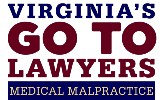Helping
the Injured
Key Appellate Cases
Because the results obtained in specific cases depend on a variety of factors unique to each case, past case results do not guarantee or predict a similar result in future cases undertaken by a lawyer or law firm.
Supreme Court Sides with Frei, Mims and Perushek on Commonwealth’s Exposure
A woman was injured when the vehicle in which she was riding went off the road and rolled over due to a steep drop-off on the shoulder. She and the car’s driver reached a settlement of $100,000. A suit for $1.5 million was brought against the Commonwealth for improper maintenance of the road. The Commonwealth convinced the trial court to reduce the amount of the plaintiff’s ad damnum (the amount sued for) to $100,000 because that is the statutory limit on the amount that may be recovered from the Commonwealth. The trial court then granted a motion to dismiss by the Commonwealth, holding that plaintiff had already received $100,000 from the settling tortfeasor (driver of the car), and since $100,000 is the statutory limit to be recovered from the state, the plaintiff could not recover anything from the Commonwealth. In this case of first impression, the Supreme Court agreed with Plaintiff that the trial court erred in reducing the ad damnum prior to a jury verdict. The $100,000 statutory limit is simply a limit on the amount the Commonwealth may have to pay; it is not a limit on the amount for which the Commonwealth may be sued. The Court accepted Plaintiff’s argument that the two statutes involved (the $100,000 limit on recovery against the Commonwealth and the statute governing settlements with a tortfeasor) were not inconsistent and that the proper order of reduction in harmonizing the two statutes was to reduce a jury verdict by the amount received from the settling tort feasor and then to apply the $100,000 statutory limit on the Commonwealth’s exposure.
Torloni v. Com., 645 S.E.2d 487
Supreme Court Upholds Frei, Mims and Perushek’ Right to Show Expert’s Bias
During the trial of this motor vehicle accident case, Plaintiff’s counsel was allowed, during cross-examination of defendant’s medical witness and during closing statement, to impeach defendant’s medical expert witness by mentioning liability insurance in connection with the expert’s relationship to the defending liability insurance company. The insurance company had paid the expert over $100,000 a year in the two years preceding the trial. The trial court gave a cautionary instruction to the jury that evidence of the amounts paid to the expert witness by the insurance company defending the case could only be considered in connection with the bias of the witness. After the jury returned a verdict in favor of the plaintiff, the defendant appealed on the grounds that under the general rule intentional mention of insurance is prejudicial error. The Supreme Court held that the trial court did not abuse its discretion in allowing plaintiff’s counsel to show the potential bias or prejudice of the defendant’s Rule 4:10 expert, where, as here, the expert’s relationship with the insurance company was substantial. The Court agreed with plaintiff that the trial court properly exercised its discretion in weighing the probative value of the mention of insurance to show the bias of the witness against any prejudicial effect.
Lombard v. Rohrbaugh, 262 Va. 484, 551 S.E.2d 349 (2001)
Supreme Court Ruling Redefines Covenants not to Compete in Virginia
In 2009, Home Paramount Pest Control sued a former employee at its Falls Church branch for breaching his employment contract provisions not to compete. Paramount alleged that the employee solicited customers after he left to work for a Springfield-based competitor, Conor’s Termite and Pest Control. The Court held that Paramount’s non-compete restriction was overly broad and unenforceable because it effectively restricted former employees from performing any activity whatsoever for any competitor. Further, the Court said that the Covenant was not reasonably limited to protect only the employer’s legitimate business interests. The Court noted that the law of non-compete agreements had evolved in Virginia since 1989 in Paramount vs. Rector when it had upheld an identical covenant. Sickels represented Paramount in that case. For the Court’s full opinion go to: HOME PARAMOUNT PEST CONTROL COMPANIES, INC. v. JUSTIN SHAFFER, ET AL., No. 101837, November 4, 2011, OPINION BY JUSTICE WILLIAM C. MIMS







